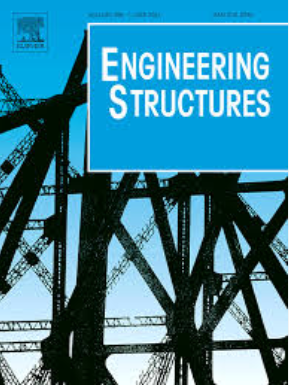一种用于低频振动防护的多向准零刚度磁悬浮平台
IF 6.4
1区 工程技术
Q1 ENGINEERING, CIVIL
引用次数: 0
摘要
在遥感卫星控制力矩陀螺等精密仪器中,保护结构是必不可少的,它需要有效的三方向隔振以实现高敏捷性。介绍了一种具有多向准零刚度特性的新型磁悬浮隔振平台。MLP集成了三个相同的磁弹簧,将x/y/z振动转换为垂直振动。这些磁性弹簧利用由定制的磁场畸变产生的恒定磁力,与传统的依赖于正刚度和负刚度元件的系统不同,后者复杂且工作行程有限。通过磁场仿真验证了磁弹簧的QZS机理,并对MLP进行了结构建模,确定了最佳工作区域。基于势能导出了正交方向和耦合平面上的静态特性,并将其可视化。建立了基于Duffing振子的正交系统无量纲动力学模型,利用传递率图和能量图分析了阻尼对非线性跳变现象的影响。通过分岔分析,探讨了振动幅值对异常动力响应(位移突变)的影响,以辅助激励选择。实验结果表明,MLP在z方向上的初始隔振频率为2.3 Hz,在x和y方向上的初始隔振频率为4.3 Hz,证明了MLP的低频隔振能力。本文章由计算机程序翻译,如有差异,请以英文原文为准。
A magnetically levitated platform with multi-directional quasi-zero stiffness for low-frequency vibration protection
Protective structures are essential for precision instruments like control moment gyros (CMGs) in remote sensing satellites, which require effective three-directional vibration isolation for high agility. This paper introduces an innovative magnetic levitation platform (MLP) for vibration isolation, featuring multi-directional quasi-zero stiffness (QZS) characteristics. The MLP incorporates three identical magnetic springs that convert x/y/z vibrations into vertical ones. These magnetic springs utilize a constant magnetic force generated by a customized magnetic field distortion, differing from traditional systems that rely on positive and negative stiffness elements, which are complex and have limited working strokes. The QZS mechanism of the magnetic spring is demonstrated through magnetic field simulations, followed by structural modeling of the MLP to identify the optimal operating region. Static properties in orthogonal directions and coupling planes are derived and visualized based on potential energy. A dimensionless dynamic model of the orthogonal system is established as a Duffing oscillator, and the effects of damping on nonlinear jumping phenomena are analyzed using transmissibility and energy diagrams. The influence of vibration amplitudes on abnormal dynamic responses (displacement mutations) is explored through bifurcation analysis to assist excitation selection. Experimental results show that the initial vibration isolation frequency is 2.3 Hz in the z direction and 4.3 Hz in the x and y directions, demonstrating the MLP’s capability for low-frequency vibration isolation.
求助全文
通过发布文献求助,成功后即可免费获取论文全文。
去求助
来源期刊

Engineering Structures
工程技术-工程:土木
CiteScore
10.20
自引率
14.50%
发文量
1385
审稿时长
67 days
期刊介绍:
Engineering Structures provides a forum for a broad blend of scientific and technical papers to reflect the evolving needs of the structural engineering and structural mechanics communities. Particularly welcome are contributions dealing with applications of structural engineering and mechanics principles in all areas of technology. The journal aspires to a broad and integrated coverage of the effects of dynamic loadings and of the modelling techniques whereby the structural response to these loadings may be computed.
The scope of Engineering Structures encompasses, but is not restricted to, the following areas: infrastructure engineering; earthquake engineering; structure-fluid-soil interaction; wind engineering; fire engineering; blast engineering; structural reliability/stability; life assessment/integrity; structural health monitoring; multi-hazard engineering; structural dynamics; optimization; expert systems; experimental modelling; performance-based design; multiscale analysis; value engineering.
Topics of interest include: tall buildings; innovative structures; environmentally responsive structures; bridges; stadiums; commercial and public buildings; transmission towers; television and telecommunication masts; foldable structures; cooling towers; plates and shells; suspension structures; protective structures; smart structures; nuclear reactors; dams; pressure vessels; pipelines; tunnels.
Engineering Structures also publishes review articles, short communications and discussions, book reviews, and a diary on international events related to any aspect of structural engineering.
 求助内容:
求助内容: 应助结果提醒方式:
应助结果提醒方式:


